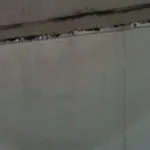Got Leaks Chicago? Tuckpointing and Sealing May Be the Answer

Saturation Leaks
It may surprise you but masonry is not entirely waterproof. Brick does absorb water. When water passes through or absorbs entirely into the porous surface of a masonry wall to the extent that moisture finds its way into your living space it is called a saturation leak.
Saturation leaks don’t show up every time it rains. That’s because light rain won’t provide enough moisture for the masonry to become saturated and transfer completely through the wall.
Saturation leakage becomes a problem when the water shows up in some occupied or living environment, causing noticeable damage to ceilings, walls or floors. Staining is more often the sign of a saturation leak, rather than water drips or puddles on a floor. Efflorescence or a powdery white substance also appears with saturation leaks. If under wallpaper, efflorescence will give a bumpy like appearance. Paints will eventually blister and crack if efflorescence is present on the wall.
A common area where saturation leaks are found is where the chimney passes through the roof. However, whenever water can run down or moisture is held against a masonry wall (snow) there is a possibility for saturation leaks. Look for failed gutters or downspouts that may be streaming water onto the masonry.
Problem masonry areas can be treated with a water-repellant sealant that reduces the porosity of the masonry. Consult a tuckpointing or masonry professional to determine the right sealant for your building.
Void Leaks
Leaks caused by stress cracks, holes, or missing mortar can sometimes look similar to a saturate leak. Exterior walls should be inspected for problems that could cause or contribute to a saturate leak. It is not uncommon for leaks to have multiple causes. Unlike a saturation leak, void leaks usually occur almost every time it rains. Water streams are visible running down a wall or spread out from a center point of origin. These leaks are usually isolated to a single area.
Leak diagnosis is no easy task, but experienced masonry professionals can help identify problems and find solutions. Shamrock Tuckpointing can keep your Chicago masonry buildings free from leaks.


